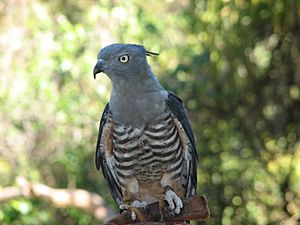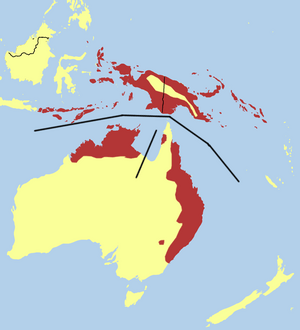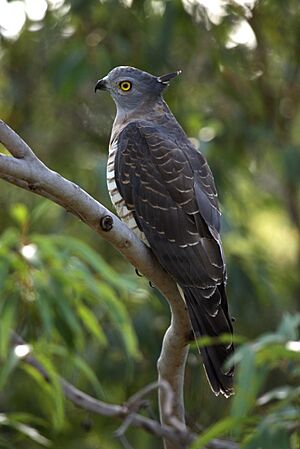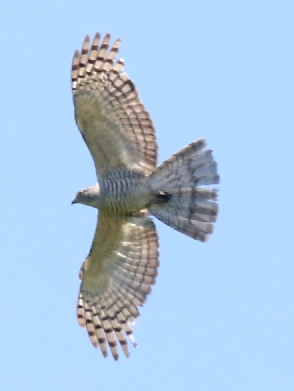Pacific baza facts for kids
Quick facts for kids Pacific baza |
|
|---|---|
 |
|
| Conservation status | |
| Scientific classification | |
| Genus: |
Aviceda
|
| Species: |
subcristata
|
 |
|
| Distribution of the Pacific baza. Lines demarcate some subspecies, but note that there are actually 13 in total. | |
The Pacific baza (Aviceda subcristata) is a medium-sized hawk. People also call it the crested hawk or crested baza. It is mostly grey, brown, and white. This bird grows to be about 35–46 centimetres (14–18 in) long.
The Pacific baza eats both plants and animals, making it an omnivore. It usually stays in one place and does not migrate far. Its breeding season starts in September and can last until February. During this time, these birds often fly and make sounds to attract mates. You can find the Pacific baza in Australia, Indonesia, Papua New Guinea, Solomon Islands, and East Timor. It lives in forests, savannas, and near freshwater. The International Union for the Conservation of Nature lists it as a least concern species. This means it is not currently in danger of disappearing.
Contents
About the Pacific Baza's Name
The Pacific baza was first described by John Gould in 1838. He gave it the scientific name Lepidogenys subcristatus. Later, scientists decided it belonged to the Aviceda group.
The name Aviceda comes from Latin words. Avis means "bird" and caedere means "to kill". So, Aviceda means "bird-killer". The second part of its name, subcristata, also comes from Latin. It means "somewhat crested". This refers to the small crest on the back of its neck.
Even though it was once called the crested hawk, "Pacific baza" is now the most common name for this bird. There are 13 different types, or subspecies, of the Pacific baza. Each subspecies lives in a slightly different area.
What the Pacific Baza Looks Like
The Pacific baza is a slender, medium-sized bird. It has a slim head and neck. It looks similar to other birds in its group. This bird is about 35–46 centimetres (14–18 in) long. Its wings can spread up to 80–105 centimetres (31–41 in) wide. Its tail is about 19–23 centimetres (7.5–9.1 in) long. It weighs between 260–450 grams (9.2–15.9 oz). Female birds are usually a little heavier than males.
The underside of the bird is white with black stripes. Its back is grey, and its shoulders are brown. It has a small, grey head and round, yellow eyes. Its upper legs are reddish-brown, and its feet are grey. When it flies in circles, you can see bands on its "fingers" (the tips of its wings).
The Pacific baza is the only raptor in New Guinea that has a crest. This is a small, spiky tuft of feathers on the back of its neck. Its wings are wide, rounded, and shaped like paddles. They are very large compared to its body. The bird's tail is long and square-ended, with a black tip. It is about the same length as the rest of its body.
You can tell females from males because females have a slightly browner back. They sometimes have more stripes on their wing feathers. Young birds, called juveniles, have a much browner back than adults. Their eyes are pale, not bright yellow like adult eyes. Juveniles also have a patterned face, smaller stripes on their belly, and a rust-colored chest. Their throat is white, and the part above their beak (called the cere) is cream to blue-grey.
Pacific Baza Behaviour
Diet and Hunting
The Pacific baza is an omnivore. This means it eats both plants and animals. Its diet includes fruits, insects, tree-frogs, lizards, snakes, and even other birds. Scientists used to think it only ate meat and ate fruit by accident. But now we know it often eats fruit on purpose.
This bird hunts in the tops of trees. It dives down into leaves or the air to catch its prey. Some people say it can copy the calls of tree-frogs to make them call back. This might help the baza find them.
Sounds and Migration
The Pacific baza makes a "pee-peow, pee-peow" sound. The first part of the call goes up in pitch, and the second part goes down.
Most Pacific bazas do not migrate, meaning they stay in the same area all year. However, some groups in Australia have been known to move short distances. These birds are generally quiet and gentle. They are also social birds. Many of them often gather together when it's not breeding season.
Reproduction and Life Cycle
The breeding season for the Pacific baza usually begins in September. In Australia, it lasts until February, but it can be longer in other countries. During this time, the birds often fly up and down in the sky to show off. They make V-shapes with their wings when they fly down. They have also been seen doing somersaults in the air.
Their nests are made of sticks and are often flimsy. They build these nests high up in tree branches. A female Pacific baza usually lays 1 to 4 eggs. The eggs are white and sometimes have spots. Both the male and female birds take turns sitting on the eggs to keep them warm. They switch places about every 1.5 hours.
One family of bazas was studied. The parents spent about 16 days getting ready to lay eggs. The eggs then took 29 days to hatch. The young birds stayed in the nest for 35 days. After leaving the nest, the young birds became independent from their parents in at least 22 days. A Pacific baza typically lives for about 7.6 years.
Where the Pacific Baza Lives
The Pacific baza lives in warm and humid parts of the Australasian realm. You can find it breeding in Australia, Indonesia, Papua New Guinea, and the Solomon Islands. It also lives permanently in East Timor. In Australia, it mostly lives in northern and eastern areas, usually within 400 kilometres (250 mi) of the coast.
The total area where this bird lives is very large, about 11,100,000 square kilometres (1.11×1013 m2). Its homes are subtropical and tropical forests, dry savannas, and areas near freshwater. This includes wetlands, streams, and rivers. They usually live at heights less than 1,000 metres (3,300 ft) above sea level. They rarely live higher than 1,300 metres (4,300 ft).
Because the Pacific baza lives in such a large area and its population is stable, it is listed as a least concern species. This means it is not considered to be at risk of extinction by the IUCN Red List.
See also
 In Spanish: Baza australiano para niños
In Spanish: Baza australiano para niños




